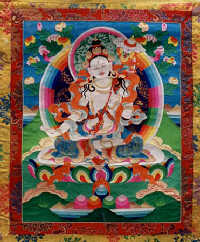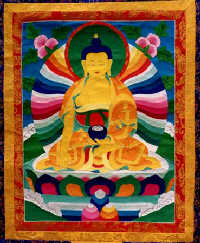|
Thangka, A Unique Tibetan Culture
( 2005-10-17 )
  Content Content
The content of thangka covers various subjects such as historical events, personage biographies, religious doctrines, Tibetan natural conditions and social customs, folklores, myths, and images of great deities and Buddhas.
The content also encompasses Jataka stories of the Buddha, and so on, involving politics, economy, history, religion, literature and art, social life, Tibetan astrology, pharmacology, theology, and many other respects.
The structure of Tibetan thangka is precise, balanced, thick, and flexible. The painting methods are mainly bright color and line drawing.
Thangka always has a Buddhist theme, and the artists must follow the sacred laws for portraying gods and Buddhas. Passages from scriptures are written in vermilion on the back, and thangkas are always unsigned, so it is next to impossible to know the painter and the age of ancient thangkas.
 Process Process
Thangkas are usually placed upright in a rectangular shape while there are a few that deal with mandala (an imaginary place that is though of during meditation) depictions that are square. Cotton canvas and linen cloth are the common fabrics on which pictures are painted with mineral and organic pigments (important thangkas use ground gold and gemstones as pigments). A typical thangka has a printed or embroidered picture mounted on a piece of colorful silk. A wooden stick is attached on the side from the bottom to the top to make it easier to hang and roll up.
To paint a thangka, an artist usually begins by stretching a piece of cotton cloth on a wooden frame along its sides. Then, a certain type of gesso (plaster) is spread over both the front and back of the canvas to block the holes and then scraped off to produce smooth surfaces.
 Afterwards, some orienting lines are drawn to guide the sketching. By following a fixed proportion, the artist creates some roughly drawn images. The featured deity or saint occupies the center while other attendant deities or monks, comparatively smaller in size, surround the central figure and along the border. Afterwards, some orienting lines are drawn to guide the sketching. By following a fixed proportion, the artist creates some roughly drawn images. The featured deity or saint occupies the center while other attendant deities or monks, comparatively smaller in size, surround the central figure and along the border.
Next is coloring. Painters apply pigments on the sketch, with black, green, red, yellow, and white as the basic colors used. All the colors are mixed with animal glue and ox bile to keep them bright. Shading is then done to produce better pictorial effects.
In the final stage, facial features and eyes are sacredly finished, only after a ritual is held on a fixed day. After the artist finishes the details, the canvas is removed from the frame and mounted on a piece of brocaded silk. The wooden sticks are attached to the top and bottom of the silk. After a dust cover of gossamer silk is attached, the thangka is ready to be hung up.
|

